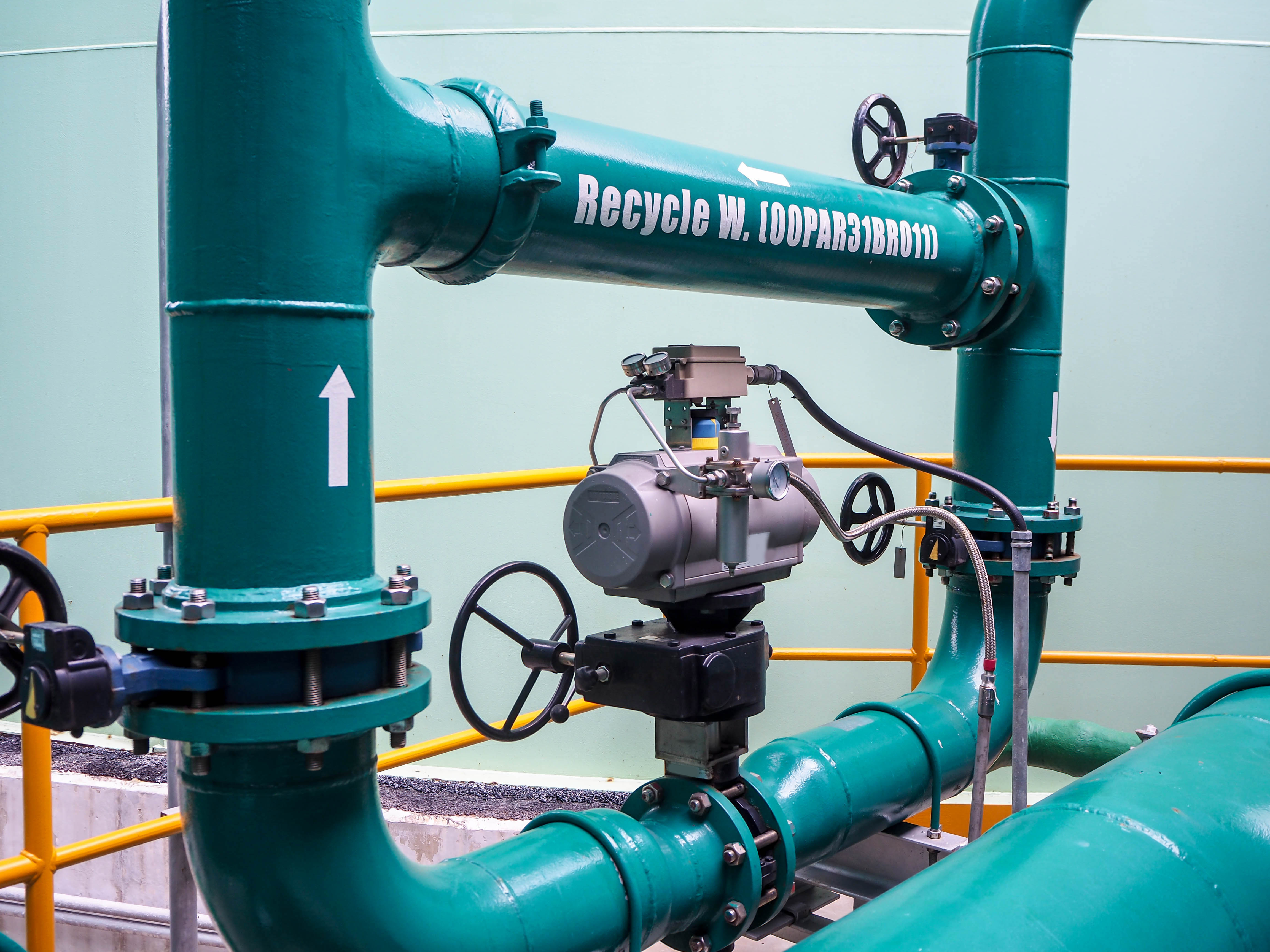Actuated Butterfly Valves 101: All You Need To Know About Their Application In Piping Systems
Posted by Jason Welsford on Aug 10th 2021
Butterfly valves are quarter-turn flow control or isolation devices, used for quick shut-off in piping systems.They have compact and lightweight designs that improve the coefficients of flow, limit pressure drops and enhance pressure recovery.
How does a butterfly valve work?
Control of the opening and closing of the valves, for isolation or throttling service, relies upon a centrally placed disc attached to a rod or shaft passing through it and connected externally to an actuator. Turning the actuator aligns the disc perpendicularly or parallel to the direction of the fluid flow.
Valve discs are of equal radial dimensions as the bore, and are continuously present in the flow - inducing a limited pressure drop in the system.
Butterfly valves are classified based on the disc closure type and the design of the ends of the valve body.
The disc closure type:
- Concentric valves whose stems lie at the centerline of the disc. It is a zero offset, rubber seated valve commonly used for low-pressure flow applications.
- Eccentric valves have the stem offset from the centerline of the disc. They are high-performance valves that use resilient seals and prevent jamming due to the rapid closing action. Eccentric valves are available as single-offset, double-offset and triple-offset valves.
The design of the ends of the valve body:
- Wafer-type valves lie between two pipe flanges, which are held together by bolts that spread across the width of the valve body.
- Lug-type valves have threads on the outer sides of the valve body, which allow a direct connection of the valve to the pipe flanges, using bolts only.
- Double-flanged butterfly valves have flanges on both ends of the valve body. These valves are easy to install and align to existing pipe configurations.
- Butt-welded butterfly valves are vital for high-pressure applications. Welding creates a permanent connection between the valve and the adjacent pipes.
Actuation methods of butterfly valves
The actuation of butterfly valves speeds up the opening and closing characteristics. Valve actuation enhances the steady, incremental flow of fluids in a piping system. An actuator provides the torque required to maximize valve operation. The following types of actuators are available for industrial butterfly valves:
1) Manual valve operation
These are rudimentary, hand-operated actuators that use a wheel, crank, or lever to control the position of the stem and the disc. They are simple, inexpensive valve operating systems that are suitable for remote pipe systems without access to power. Some large valves contain a geared system for increased torque. Advanced, gear-operated actuators have analog indicators that correspond to the approximate positions of the disc.
This category of valve operation is limited for use with small-sized valves. Their operational speed is low, making them unsuitable for critical pipe systems.
2) Electric valve actuator
The actuator uses a bi-directional motor to facilitate the remote operation of valves. The versatile actuation system incorporates a gearbox that lowers the motor speed, increasing the torque. Electric actuators are majorly maintenance-free, simple to install devices commonly used for process control in non-critical and light-duty modulation activities.. The actual position of the valve replicates as a voltage or current signal. They consume less energy and operate quietly.
Some electric actuators contain limit switches that initiate motor stoppage when the valve is fully closed or fully open. Application areas are limited to processes with a stable power supply.
3) Pneumatic valve actuators
Pneumatic actuators can be single-acting or double-acting. Their designs accommodate multiple ports for the entry and expulsion of compressed air. When the air enters the chamber of the actuator, it causes linear or rotary motion of the piston/plunger. It results in a rotational or lifting torque on the stem, causing the disc to open or close and control the flow of fluids. The actuators may contain solenoids that respond to electrical signals to control the position of the actuator.
These actuators have a compact design, are lightweight and economical. Their quick reaction time makes them suitable for repeatedly throttled pipelines, such as industrial gas service, conveying slurry and steam service. They only work when there's an external supply of compressed air.

4) Hydraulic valve actuator
Heavy-duty valves, such as main steam valves, require large turning forces to operate. Such valves require hydraulic actuators, which are available as single-acting (spring return) or double-acting actuators that use fluid pressure to open or close valves. For single-acting actuators, the absence of fluid pressure keeps the valve at a closed position. As upstream pressure builds up, the hydraulic force supplied by a fluid (hydraulic oil or sometimes water) pushes the piston upwards to open the valve. A reversal of these conditions expels the hydraulic fluid in the opposite direction, closing the valve. Double acting hydraulic actuators use an inbuilt hydraulic pump that changes the direction of the hydraulic fluid to match pipeline flow conditions.
Smaller butterfly valves use hydraulic actuators with solenoids that control the linear motion of the plunger. Hydraulic actuators provide an economical means for the automatic or semi-automatic operation of very large valves.
Valve actuator selection criteria
When choosing an actuator for butterfly valves, it is necessary to evaluate the configuration of the system. The valve body should have fitting mounting flanges, the stem needs to permit coupling with an actuator, and the bolt patterns of the flange and the actuator housing must match. Other technical considerations are:
1) Cycling requirements
The duty cycle is the ratio of the time taken by an actuator to complete valve actuation (on time) to its off time. Since valves are mechanical devices, frequent operation leads to a build-up of heat, which affects the sealing properties of the valve and leads to the damage of actuator components. Duty cycles for actuators vary depending on how frequently the valves will be operated. Hydraulic valve actuators which are used for frequently cycled, high-pressure pipe systems can have close to 100% duty cycle, while electric actuators which operate for a shorter time can have a duty cycle as low as 25%.
2) Actuator speed
The speed of actuators depends on system requirements. Frequently cycled, high-pressure and critical operations, such as chemical processes, require fast-acting actuators (hydraulic or pneumatic). On the other hand, a slow-acting actuator will be perfect for mixing operations, especially when a cold fluid gets introduced into a heated system.
3) Nature of working media
Actuators are coupled to the stem of a valve through an adaptor or mounting on the body of the valve. Coupling mechanisms expose the actuator to the working media. It is crucial to verify the nature of the working fluid, and whether it is corrosive, toxic or gaseous. The body of the actuator has to be of a similar or stronger material than the valve, to prevent leakages or damage.
4) Actuator type, design, and redundancy
System failures occur in flow operations. Actuator systems need to possess a certain level of redundancy to allow flow control and retain the safety conditions of the system. For instance, a fail-open butterfly valve using a hydraulic actuator requires a spring return mechanism to prevent contamination.
5) Cost and maintenance
Each valve actuator comes with a specified lifespan. By comparison, pneumatic actuators last longer than their electric counterparts. Within its working life, the actuator requires several maintenance interventions. The cost for maintaining or replacing the actuator should be within reach. Other considerations to be made include the cost of purchasing and maintaining ancillary equipment such as air compressors for pneumatic actuators.
Key takeaway
The choice of valve actuators for different industrial applications depends on the level of autonomy and flow requirements. Actuators should facilitate the timely operation of butterfly valves without affecting flow conditions.
Need guidance in determining the appropriate butterfly valve for a specific application?
The experts at ValveMan have the knowledge and experience to help. Shop ValveMan.com today!
Related products
[[2220, 2094]]

 888-825-8800
888-825-8800









